Bear arrea Well it seems that you go forever!
Great bear family
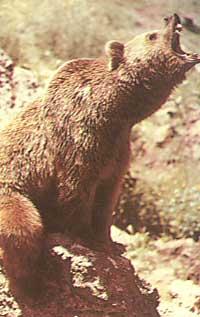
Bears living in the Basque Country or in nearby lands are of the kind of brown bears. The scientific name of this species is Ursus ardun.
This bear has close siblings and has distant cousins. The closest is the one in North America (Alaska and Canada), known as grizzly.
The bear group also has lost species throughout history: the cave bear is one of them. The remains of this bear that lived during the glaciations can be found throughout Europe. It is believed that the cause of his disappearance can be a very hard winter in those times.
Among the bears we know today there are many: It is estimated that there are 200,000 specimens of the black bear species ( Euartus americanus) that inhabits North America and 20,000 specimens of polar bear ( Thalartus maritimus in). The situation of others is not so comfortable. According to experts there are 2,000 specimens of the spectacle bear species ( Tremarcones ornatus) that inhabits the Andes. The situation of the Panda bear is also worrying. In China there are only 1,000 units.
The situation of other species, such as the Tibetan ( Selenardun thibetanus) and the anthill ( Myrmecopara tridactyla), is even more serious and it is believed that only some specimens remain.
For us the best known is the brown bear of the Pyrenees and Cantabria, as we have said. This species is found in many parts of the world, as in Europe and Asia. His close relative, who lives in North America, is the grizzly bear of the species Ursus horribilis of the same genus. In total there are 250,000 brown bears in the world, but in Europe only 30,000 remain and, moreover, it has disappeared practically in some areas previously known, such as Greece, the French and Italian Alps, and in the other two that surround us.
In the Pyrenees there are currently only 10 or 14 specimens. It is estimated that in 1970 there were 20 and in 1937 more than 150. According to the latest statistics on the number of bears, in the Pyrenees there would be no more than 14 bears. It is believed that in the Spanish party there is only one bear. The French have found remains in three areas: About ten bears in the valleys of Ossau and Aspe, one or two in the surroundings of Luchonnais and perhaps one in the area of Ariège.
In the Cantabrian mountain range the figures are somewhat higher. However, the latest accounts indicate that those optimistic data provided by those responsible for the local administration a few years ago are not justified. The latest research has revealed that the population of 120 inhabitants then mentioned is between 60 and 80 individuals. There are two separate areas. In the western part there are a total of 40 or 60 bears and in the eastern part there are only 20.
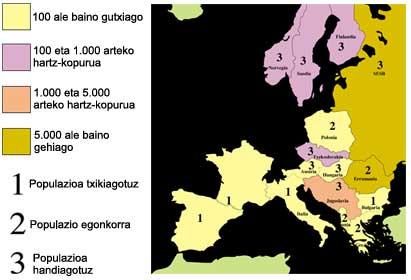
Some characteristics of the bear
The bear is an omnivorous animal. He eats a lot during the time of activity, but that amount of food is easily understandable, since he spends the winter without tasting any. Winter hibernation of the bear is not real. One of the characteristics of hibernation is to match the room temperature with that of the body, which does not happen to the bear. If its normal body temperature is 38ºC, in this species of hibernation reaches 34ºC and sometimes up to 31.2ºC. Therefore, the bear stays warm, unlike other hibernating animals.
During this period of inactivity the bear sleeps, but if it has activity capacity and can wake up by stimulation. Moreover, in this period the females give birth and until spring feed and warm the puppies while they sleep. The hibernation of the brown bear lasts four or five months: from November to April.
The brown bear is an animal between 100 and 250 kg. The male is quite larger than the female. If the males rise on the two hind legs, they reach a height of 2 m.
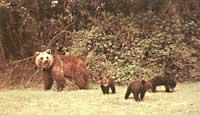
We have said that it is omnivorous. In spring, as you leave the trail and leave your hiding place, look for leaves, buds and roots to feed. In summer he likes gold, mazusta and cranberry. He also eats grain and honey. Meat doesn't get wet either, although only 10 or 20% of its food. To get this meat attacks the flocks.
He has poor eyesight, but it is a fine ear and a sharp smell. Towards the month of June they look for a couple. It is a difficult job, being such a low density population. If they find a couple and pair, one or two bears are born. With a little luck away from humans and other dangers, newborns may hope to live some twenty years.
Ancient enemies: shepherds
The sheep like bears and will attack the flock to the detriment of the shepherd. Shepherds have long had to protect themselves from wolves and bears. And for this they have used all the ways they have had at their disposal: in addition to the arts and weapons, extriknina has been used a lot. It is easier for the shepherd to put a estriknina inside a dead cattle or piece of meat and wait for the bear to arrive. In the French Pyrenees this route has been used quite a lot.
The most serious actions have been carried out in the French area for shepherds and bears to live in peace. The shepherd was entitled to receive compensation for every dead sheep. In 1989, 56 sheep and 3 goats were compensated for this reason, amounting to 1,550 pounds.
But the measures have not remained there. In order to facilitate the work of the shepherds and increase the possibility of collaborating with them on this path, a helicopter service has been implemented in France. This helicopter carries the tools and food of the shepherds to the huts, eliminating the pastor's need for various displacements. This service advances pastors from spring about 10 days of work.
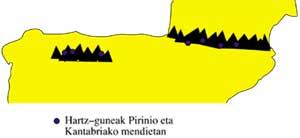
More rivals: hunters
The shepherds have not been the only enemies of the bear and in no case (at least today) they provoke most of the deaths.
The data are not entirely reliable (bear hunting is strictly prohibited in France since 1957 and in Spain since 1967), and although according to sources they are very different, some of those we have received are: In Asturias in the period 1979/1981 12 or 25 bears were killed by hand or lac according to different sources. In the years 1.986/87, 9 or 4 according to sources, and in León until 1.980/1.987, approximately 8.
However, no sanction has been imposed, although according to current regulations, the fine for hunting bear in Cantabria amounts to 2 million and that of Castilla-León to 1.5 million.
Hunting has a long tradition in these lands and closing hunting has become a big problem. Changing habits is usually not easy and, moreover, if the measures taken remain only on paper, it is more difficult to seriously defend the protected species.
What is clear is that, although the rules against the hunt of the bear are not yesterday morning, many hunters play quietly and proudly killing the bear. Cases of this type have been known both in the Pyrenees and in the mountains of Cantabria.
In 1982 a group of hunters, with their faces covered, took a photo next to the female bear and their breeding, who were killed. The photo went hand in hand in several Pyrenean valleys.
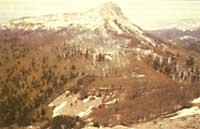
All Saints Day of 1988. In the Leonese village of Brañosera, there was a bear that a citizen ended up with his hands, in the sight of all. He said that he attacked him and that they were shots in self-defense. Studies of the bear did not reveal what the hunter said: those of the FAPAS claim that they were shots received in the position of the fugitive. This group has wanted to carry out the complaint in this case
The most effective way to avoid hunting Ixil is by creating Parks. Thus, protected animals are not so endangered. But both the Pyrenees Park and the National Reserves of the Mounts Cantabrians do not include at all the habitat of the bear, since neither of the two cases, in the decision making the problem of the bear was raised.
Habitat problems: new enemies
The lack of compatibility between hunting and bear does not come only through shooting. The hunt for wild boar, permitted by law, has also caused problems in the Pyrenees. The hunting territories of the wild boar, often coinciding with those of the bear, besides that the hunts occur in a very delicate time for the bear. This brings us to the third point that may be the key to the problem: in short, and for the bear to survive in these territories, its habitat must be preserved in its entirety. Although the activity of the herders or hunters of closure, with all the particularities that each one needs, is controlled, the objectives will hardly be achieved if their habitat is not protected.
The bear lives in the forest and does not want any activity around him. The cutting of the forest, the construction of tracks or roads, the cable car, the ski slope and the picnic environment and other activities that are carried out in the name of the tourist exploitation degrade the habitat of the bear and goes in search of new territories.
Just one example. The bears of the Aspe valley never cross the existing road, so to say that there are about 10 bears in it does not describe reality, but are divided into two unrelated sets.
The information provided to assess the potential impact of tourism pressure depends on the interests of the source. Witness of what happened in the Abruzzo National Park of Italy. This park was born in 1923 with the aim of protecting the brown bear. The population of around 100 individuals declined by 40% between 1970 and 1986, tripling their range. According to the researchers, the spectacular rise of tourism during these years caused the bears to spread to new territories in search of quiet areas. These territories, being outside the park, were in the hands of the closing hunters, which explains the high mortality. But this data is only read in some jobs. In other articles and folios, the case of Abruzzo is mentioned as an exemplary project that has been successful in conservation, ensuring that conservation is consistent with the economic recovery of these valleys for tourist reasons.
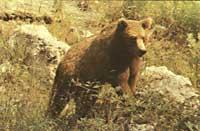
In the case of Cantabria there have also been complaints of manipulation. According to a study conducted a few years ago by the local administration, it announced 120 bears. Therefore, the gravity of the situation softened. On the contrary, research conducted by independent researchers did not account for even half of the amount granted by the Administration. The administration was accused of acting unfounded; that public opinion was pushing the excess of optimism into jeopardizing the safety of conditions for bear survival.
Bear conservation groups have now been concerned about the Administration's plans for the different areas of the Cantabrian Cordillera. The Administration does not speak directly of tourism, but of the improvement of infrastructures for the inhabitants of their villages, objectives that are not so clearly reflected in the plans. It is not very clear what kind of help will be given to pastoralists or forestalists in the picnic area at the end of a cable car.
This is a conflict that is happening lately in our society and is repeated a lot by different problems: conservation versus development. It is a conflict with many nuances and that we must analyze in each case carefully if we want to avoid excesses. We must not forget that there are problems that emerge opposing interests.
Meanwhile, the bear is around us. In the dispute he is awaiting the decisions made by the species that Homo Sapiens has faced. Of course, we will make different assessments of the importance of the brown bear disappearing from these territories, but if we bet on the bear we will have to act quickly and responsibly, since time is an opposite factor.
Human oakFormerly the old eüskaldun asked them to rise from the man. Yes, human is made. Txomin Peillen Animismua Zuberoa (Basque Collection of Anthropology, Haranburu Editorea, S.A. San Sebastián, 1985) in his book. Peillen himself argues that this belief that the bear is man's ancestor also appears throughout the Pyrenees and in territories as far away as Asia. This belief comes from the comparison of human anatomy and bear. Other myths also indicate the slippery boundary of the bear/human pair. Throughout the Pyrenees, both in the North and in the South, there is a myth about the relationships between the bear and women. In the pastoral Maite Basabüru, for example, a song tells the story of a girl who touches the leather with the bear. Bedaxgrip has the engraved edge. Thus says the first verse of the song:
|
Counting bearsPyrenees: 10-14 units.
In the Cantabria mountain range: 60-80 units.
|
A possibilityShaffer, an American biologist, says the minimum population viable through modelling is 40-50. That is, it would take that amount to survive at least one specimen after 100 years, in 95% of natural conditions. In most areas we are far from those figures. What is then hope? Naturalization of imported bears. Such sessions have been held in other territories and significant risks have been detected. We must ensure that the immigrant bear is genetically compatible with the natives. |
Buletina
Bidali zure helbide elektronikoa eta jaso asteroko buletina zure sarrera-ontzian











